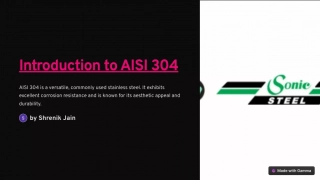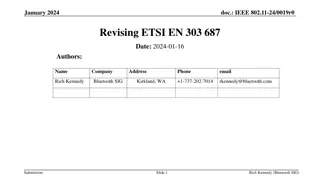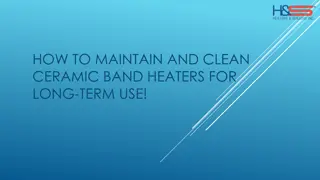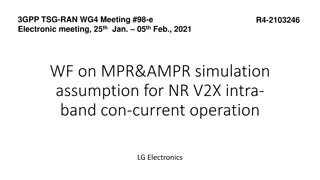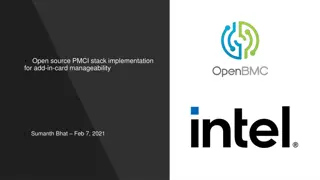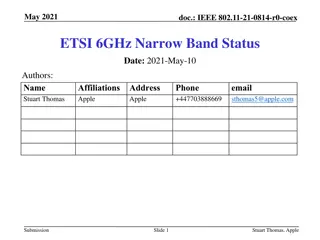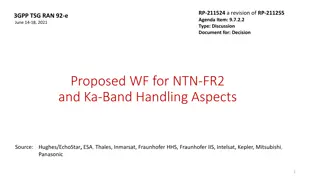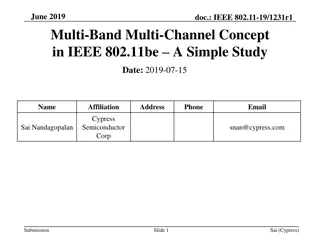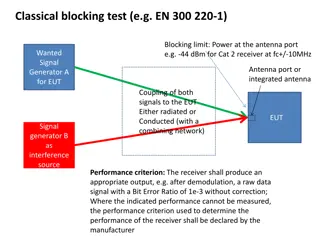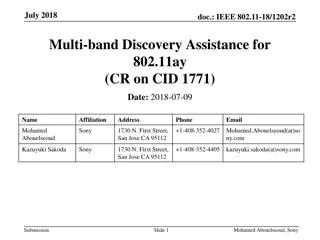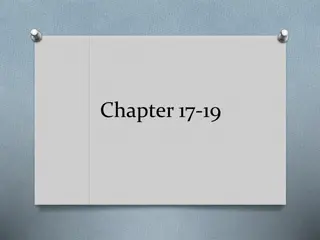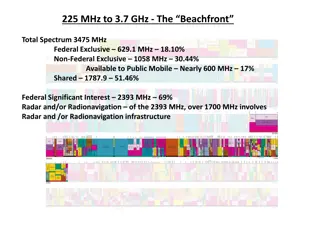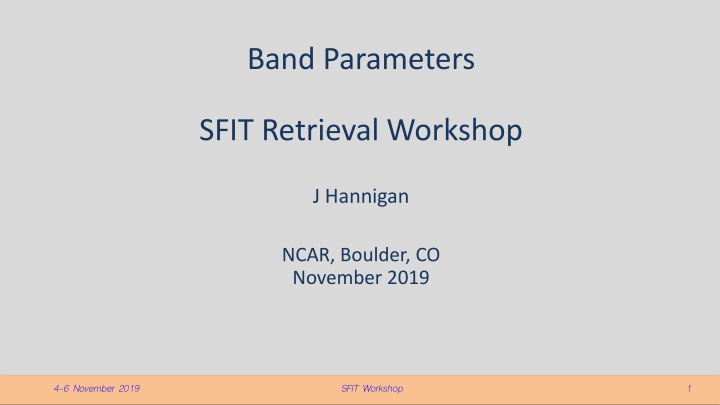
Band Parameters SFIT Retrieval Workshop Summary
Explore band parameters and spectra in the SFIT Retrieval Workshop by J. Hannigan at NCAR, Boulder. Understand band numbering, microwindows, apodization codes, and more. Dive into the details of the workshop held in November 2019.
Download Presentation

Please find below an Image/Link to download the presentation.
The content on the website is provided AS IS for your information and personal use only. It may not be sold, licensed, or shared on other websites without obtaining consent from the author. If you encounter any issues during the download, it is possible that the publisher has removed the file from their server.
You are allowed to download the files provided on this website for personal or commercial use, subject to the condition that they are used lawfully. All files are the property of their respective owners.
The content on the website is provided AS IS for your information and personal use only. It may not be sold, licensed, or shared on other websites without obtaining consent from the author.
E N D
Presentation Transcript
Band Parameters SFIT Retrieval Workshop J Hannigan NCAR, Boulder, CO November 2019 4-6 November 2019 SFIT Workshop 1
Outline Review of band parameters Review of spectra parameters Summary 4-6 November 2019 SFIT Workshop 2
Band Parameters 1/6 The Band Parameter section defines the regions to be fitted. There can be several bands. They are numbered 1, 2, and should be numbered in increasing wavenumber order. The current value of MAXBND=125 (huh?!) set in params.f90 Bandpass limits are used to determine range of lines stored by hbin Bandpass limits are used to create the spectra in the t15asc file 4-6 November 2019 SFIT Workshop 3
Band Parameters 2/6 # Microwindows and their parameters from CO2 isotope example band = 1 band.1.nu_start = 4872.000 band.1.nu_stop = 4888.000 band.1.calc_point_space = 0.900E-03 band.1.wave_factor = 1.000 band.1.max_opd = 100.000 band.1.omega = 1.914 band.1.apodization_code = 0 band.1.snr = 800.0 band.1.zshift = T band.1.zshift.type = 1 band.1.zshift.apriori = 0.000 band.1.zshift.sigma = 0.0100 band.1.beam = 1 band.1.beam.model = IP band.1.beam.1.apriori = 0.01161 1.97530 4882.98981 0.00000 band.1.beam.1.sa = 0.01 0.01 0.01 0.000 band.1.gasb = CO2 O13CO CO18O HDO H2O H218O band.1.tempretb = F 4-6 November 2019 SFIT Workshop 4
Band Parameters 3/6 Apodization Codes: 0 Boxcar 1 -3 Norton Beer (weak, med., strng) 4 - Denver data 5 Triangle 6 - Happ Genzel 7 KPNO Atmospheric Spectra A 8 KPNO Atmospheric Spectra B 9 Hamming function # Microwindows and their parameters from CO2 isotope example band = 1 band.1.nu_start = 4872.000 band.1.nu_stop = 4888.000 band.1.calc_point_space = 0.900E-03 band.1.wave_factor = 1.000 band.1.max_opd = 100.000 band.1.omega = 1.914 band.1.apodization_code = 0 band.1.snr = 800.0 calc_point_space spacing will be the nearest value to this that is an integer multiple of the observed spectrum spacing in the t15asc file. All spectra in this band must have the same spacing. Keep track of NSPAC. DN DN a desired spacing that the forward model will use for the monochromatic spectrum. Actual wave_factor WAVFAC WAVFAC a scaling that can be applied to the spectra wavenumber values. (I never used this) max_opd PMAX PMAX optical path difference of this spectrum [cm] omega - OMEGA OMEGA aperture diameter / focal length[rad] apodization_code IAP IAP defined in BOBAPD snr SCNSNR SCNSNR an snr for all spectra in this band, is overridden by value in t15asc (hence a default value) 4-6 November 2019 SFIT Workshop 5
Band Parameters 4/6 # Microwindows and their parameters from CO2 isotope example band.1.zshift = T band.1.zshift.type = 1 band.1.zshift.apriori = 0.000 band.1.zshift.sigma = 0.0100 band.1.gasb = CO2 O13CO CO18O HDO H2O H218O band.1.tempretb = F IZERO Codes: 0 zero shift the spectrum using the a priori value as given do not fit 1 - retrieve zero level for this band 2 - use zero level from first band in list for this band zshift F_ZSHIFT F_ZSHIFT flag to switch on a zero shift in this band zshift.type - IZERO IZERO function code see right -> zshift.apriori - ZSHIFT ZSHIFT initial zero shift zshift.sigma - SZERO SZERO zero shift uncertainty required when retrieving gasb - GASB GASB list of gases to retrieve in this band tempretb - TRETB TRETB flag to retrieve temperature using this band Important distinction between an absorption feature in a given bandpass and retrieving it. In short, if a gas is in the GASB then there is a block the K matrix for that gas / wavenumber remember K= F/ x. F is the forward model ie. spectrum and, x is the state vector. GASB GASB is used to build the K matrix. GASB list, 4-6 November 2019 SFIT Workshop 6
Band Parameters 5/6 # Microwindows and their parameters from CO2 isotope example band.1.beam = 1 band.1.beam.model = PS band.1.beam.1.apriori = 0.01161 1.97530 4882.98981 0.00000 band.1.beam.1.sa = 0.01 0.01 0.01 0.000 beam - NBEAMS - number of beams in this bandpass, (MAX_NUM_OF_BEAMS = 20 way too many) model - CHANNEL_MODEL_OF_BAND - model for implementation of a realized channel spectrum PS: phase shifted reflecting model or IP: interferogram perturbation model apriori - CCIPARM - parameters used: Amplitude of channel [fractional value] Frequency [cm-1] Wavenumber of zero amplitude [cm-1] Linear scale to a change in amplitude [fractional/wavenumber] sa - SCHAN_SCALE - uncertainty of each parameter if value is zero it will not be fit. 4-6 November 2019 SFIT Workshop 7
Band Parameters 6/6 Note on NSPAC Ratio between the spacing of the observed spectrum and monochromatic spectrum A cross-section value is calculated at each monochromatic point / layer / gas. So it s computationally expensive to have NSPAC large. For high resolution work where point spacing is already very small a value of 3-4 seems to work well. Note smaller spacing reduces interpolations during the wavenumber shifts For lower resolution e.g. 1 cm-1, a much higher value seems to work better, why? 4-6 November 2019 SFIT Workshop 8
Spectrum Parameters 1/2 # spectrum parameters sp.snr = 1 2 sp.snr.1.nu_start = 4882.0 sp.snr.1.nu_stop = 4888.0 sp.snr.1.snr = 200.0 sp.snr.2.nu_start = 4884.3 sp.snr.2.nu_stop = 4884.5 sp.snr.2.snr = 0.01 snr - NSNR List of number of snr ranges (MAXSNR = 20) nu_start - WWV0 Low wavenumber for this snr range nu_stop - WWV1 High wavenumber for this snr range Snr - GSTNR Constant SNR for this range This functionality was first implemented to de-value a section of a spectrum in the fit. For instance a feature that is has a bad line parameter can have a low SNR (=0.01 ?) set and its poor fit will largely have no effect on the retrieval. It can be used to override the SNR in the t15asc file 4-6 November 2019 SFIT Workshop 9
Spectrum Parameters 2/2 Note on SNR In the OE method the statistics Sa on the state vector x and Se on the measurement y are of ultimate importance. After the SNR for each point in the observed spectra is defined per rules listed above Se = 1/SNR. But the Gaussian noise on an FTIR spectrum constant and can be measured. Hence be very aware that any change will manipulate the retrieval. 4-6 November 2019 SFIT Workshop 10
Summary The band parameters provide a lot of flexibility to tailor your retrieval. Some parameters are still there but may not serve a contemporary use in one s view but may still have utility for some users. As with all parameters it s the users responsibility to know what to use and what affect a default value is having. Its important to know how the Savalues mix in the retrieval. 4-6 November 2019 SFIT Workshop 11
end 4-6 November 2019 SFIT Workshop 12


